Martin Butera visits Radio Guarujá
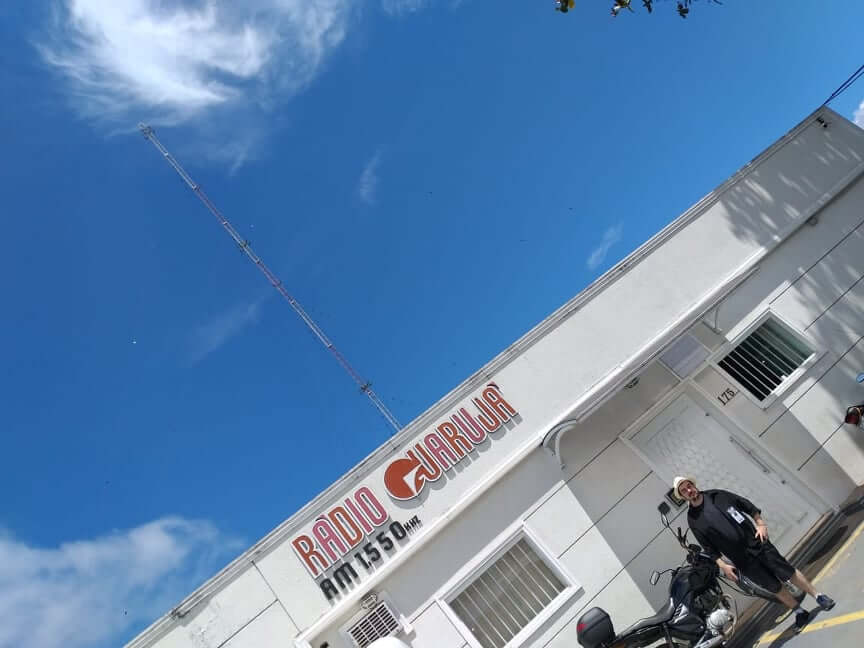
Guarujá is a municipality in the state Brazilian of San Pablo, located at a latitude of 23º 59 ’18 “South and longitude of 46º 14′ 32” West.
“Guarujá” is a term of Tupi origin that for some people means “bird master” or “bird chief”.
Brief Introduction to the History of Radio Guaruja
ZYK 590 (AM)
Radio Guarujá Paulista began broadcasting in the city, according to the data provided by ANATEL (Agência Nacional de Telecomunicações – Brazil), between the mid and late 1940s.
Currently the studios and transmitter plant is located in the area of Pitangueiras, a Santa Rosa neighborhood, duly assigned and domiciled in the street, José Vaz Porto, number 175.
The AM service, which operates at 1,550 kHz, covers several frequencies: medium waves, short waves and tropical waves. In shortwave, it operate at 5045 kHz and 3385 kHz.
It was the only radio station of “Baixada Santista” that does broadcast in short waves. The programming on these frequencies are the same as in the medium wave (AM).
Guarujá Radio during all these years witnessed historical moments of the city (political, social, sports) and has beyond the commercial aspect, an invaluable value for the population.
Radio Guarujá AM reached the pinnacle of the audience support. The numbers are impressive. Approximately 40% of the inhabitants of “Baixada Santista” tuned their radios on to Radio Guarujá AM.
FM ZYD 815 (FM)
Guarujá Paulista Radio also has commercial facilities in the neighbouring city of Santos, Sao Paulo, where it operates a station on frequency modulation mode (FM). The FM operations began on the 101.7 MHz, in the mid-1970s, with studios located in Praça da República, in the Santos Center.
At the end of 1987, there was an agreement between a group of businessmen from an Osasco station in Sao Paulo, called Alpha FM, which operated on the frequency of 104.5 MHz. Radio Guarujá, which transmitted on 101.7 MHz, reached an agreement and exchanged between the frequencies, that way both could significantly increase their coverage area.
With the change in frequency Radio Guarujá FM, came close to the position of the other radio stations on the radio dial which the listeners tuned in regularly: Tribune (105.5 MHz) and Culture (106.7 MHz). In turn, the Osasco station (Alpha FM), would be closer, on the dial vis-à-vis the traditional stations of São Paulo, such as Jovem Pan (100.9) and Transamérica (100.1). The two radios signed into such agreement.
This change in frequency had the much desired effect, because after such an arduous task of consolidating the new position on the radio dial, Radio Guarujá FM has, since 1996, considered as the benchmark of IBOPE (Brazilian Institute of Public and Statistical Opinion), the first place in audience in all Santos.
The “other” Guarujá AM
There is another Guarujá radio station in Florianopolis, a city in southern Brazil, in the state of Santa Catarina, established in 1942 and broadcasts its programme on a frequency of 1420 kHz.
The choice of the name was a curious case, at that time as the inhabitants of the city could only tune in to two radio stations. They were: National Radio of Rio de Janeiro and Radio Atlantica, from the city of Santos.
On Radio Atlantica, complimentary messages to the beaches of Guarujá were common, as were comments on the elegance and opulence of their regular listeners. Thus, in Florianopolis, at that time, Guarujá became synonymous with elegant and luxurious things.
The name became fashionable and that way the station, was baptised with the name of “Guarujá”.
Interview with Orivaldo Rampazo
After several phone calls, e-mails and follow-ups, I finally managed to schedule a meeting with Orivaldo Rampazo.
It was an interview of only a few minutes, but of great importance. It was not difficult for me to read his mind in that short time to find that Don Orivaldo is truly passionate about radio.
In 1969, Orivaldo Rampazo was invited to take over the management of Radio Guarujá and 5 years later he would become the owner of the station.
Orivaldo Rampazo is a person of great historical importance not only for the Radio Guarujá, but also for the city of Guarujá.
He participated very actively in politics, trying to improve and solve the problems of the inhabitants of the city of Guaruja and he did so without taking up positions.
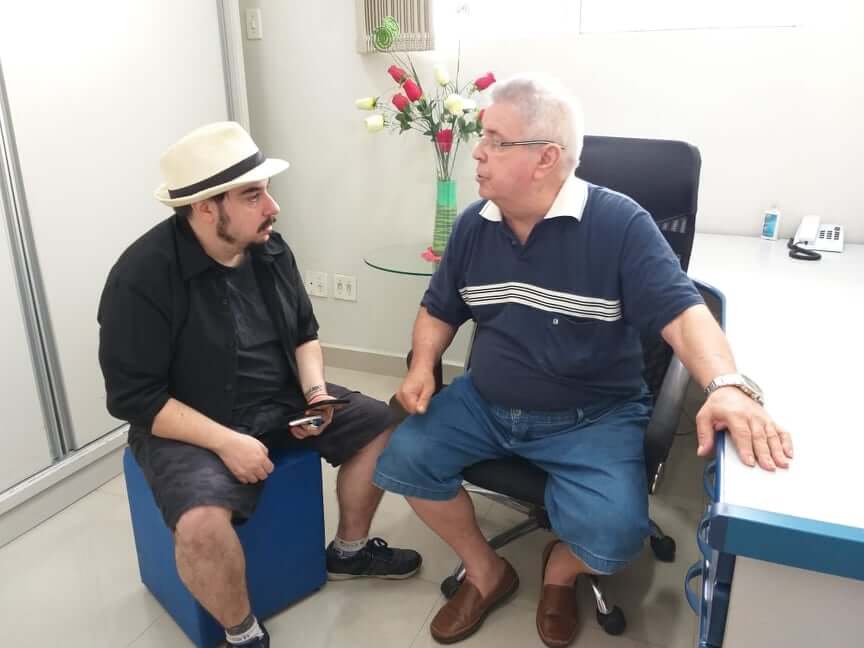
MB: How did you start in radio?
OR: You see, I started working from a very young age, I worked in a furniture store as a polisher and one day by chance, they sent me to polish some furniture in a radio a station called Clube de Tupa AM 1320 radio.
They started giving me a sort of voice test which I was answering, until someone said, that I had a wonderful voice for radio.
Then I asked what I needed to be an announcer and they told me that I had to know how to read the newspapers very well and exercise my voice and that is how I prepared for the tests and started working as an announcer, going through several stations in Sao Paulo, as an announcer in different areas like information, sports, commercial etc.
At the end of the 60s I proposed to take up the post of manager of Guaruja radio and 5 years later I became its director and here I am since then.
MB: What do you like most: AM, FM or Shortwave broadcasting?
OR: Without a doubt, for me the best of radio is in modulated amplitude, in fact I hardly go to the FM radio as it is in the neighboring city.
MB: However, you are often considered as a supporter for FM?
OR: It was like that in FM, we were the pioneers, the first FM of the “Baixada Santista” was ours, we began to broadcast in 1974, with a small transmitter of 80 W and a single dipole. I dare to even say that we were one of the first FM stations in Sao Paulo.
MB: And how did your relationship with shortwave come into being?
OR: I always love shortwave. I lived in Sao Paolo and as a kid the only way to remain informed was by listening to shortwave radios, both Brazilian and international.
MB: Do you remember what radios you were listening to then?
OR: Of course, I listened a lot to the BBC in London, The Voice of America. I remember when I grew up and was working as a journalist, I learnt about the death of John Fitzgerald Kennedy on shortwave radio and took the lead in Lins Rádio Clube, an AM station, from the interior of Sao Paulo about 400 kilometers away from the capital.
Of the Brazilian radios, I liked to listen to the radio station Rádio Brasil Central of the city of Goiânia, the capital of the state of Goiás.
MB: Were you also a DXer?
OR: If you really liked the QSL confirmations, I have some very interesting ones. I also participated in several DXcamps of the DX Clube do Brasil. Some of them were very important as one of the Cumprida Island of 2003 (São Paulo, Brazil).
MB: And what was it like having your own shortwave station?
OR: In 2003, I acquired the tropical wave license of the Rádio Clube de Marília, a city in the interior of Sao Paulo, and another city in the interior of Sao Paulo, the Rádio Diffusora of Presidente Prudente, it was a dream come true.
They remained on air for about 5 to 6 years, until for economic reasons and for a little pressure from my home, my family did not think the shortwave operations as something profitable.
I tried to explain to them that one may not have a massive or profitable audience, but those of us who love radio with a capital letter know what the shortwave means.
The short wave is still an exceptionally good radio tool.
MB: Is your radio a family legacy?
OR: I would explain it with a simple word, Guaruja radio is love, the family legacy, five children of mine, the son-in-law and even the grandchildren continue in that.
As this interview ended, I got that word “love”, Orivaldo Rampazo, a radio man who knew how to build his own dream. Radio Guaruja AM 1,550 kHz, a family legacy, that seems to have no end.
Interview with Erminio Matos (coordinator of journalism and coordination of the broadcaster in general)
With a forward-thinking, direct strategy, it’s amazing what Erminio Matos, son-in-law of Orivaldo Rampazzo, achieved in recent years.
The increase in the number of audience and a quantum leap in radio advertising for Guaruja AM 1,550 kHz. Easy task, given to the larger audiences, of the current medium-wave stations.
Erminio Matos, takes care of journalism and coordinates with Simona (daughter of Rampazo Orivaldo), at the current address of Radio Guaruja AM 1,550 Khz.
Restless, and having worked in other stations of Guaruja, at the end of the 90s he joined an important station of the great capital Sao Paulo, together with great personalities of the radio of Brazil like: Paulo Lopes, Kaká Siqueira and Eli Corrêa among others.
Since 2009 he is again with Guaruja Radio.
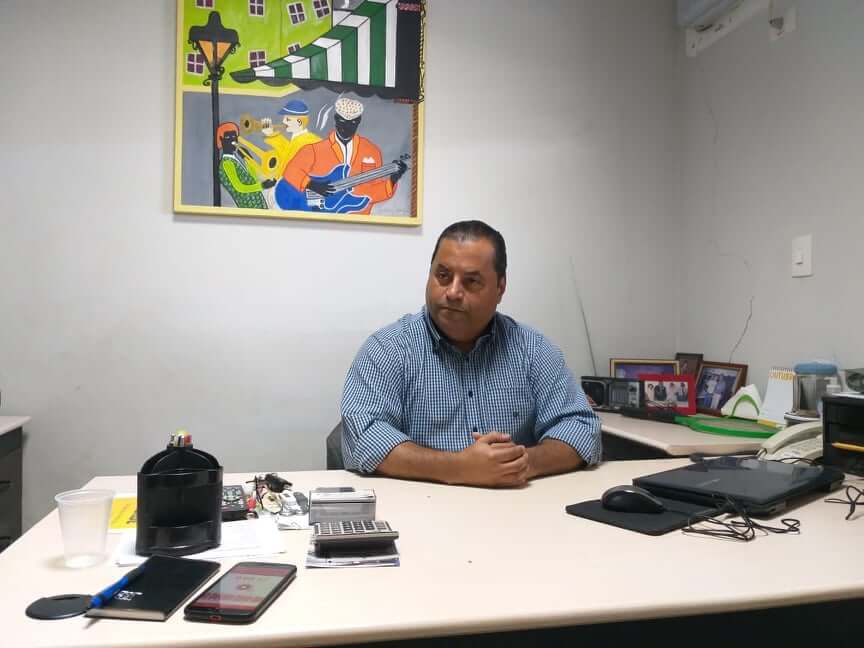
MB: What did it take to work with such important radio figures in Sao Paulo, capital?
EM: For someone from the interior of the country it is always a dream to arrive in Sao Paulo. Without a doubt those people managed to change my mind and thought process as a radio professional. Being always very frank I could understand that I needed to move or change some things.
MB: What things did you change?
EM: For example, here in the downward trend the pace is slower. I had to change my way of thinking and communicating, in Sao Paulo where there are about 12 million people. It is like a country within another country. To be able to perform here one must shoulder greater responsibility. You have to be agile and fast.
MB: Do you now impose that work culture on Radio Guaruja?
EM: Undoubtedly, all that I learned with these radio figures added a lot of value to me. Anyway I don’t allow myself to live in a world of fantasies, now I am aware about the small but great work I do here.
MB: How do you increase the audience?
EM: I have the understanding that the world changes fast. The modern world is trapped in social networks. Today people do not only have radio as “the great means of communication”.
Then using these modern resources with the radio, we set up a television-type computer program and we go out in video format through all the platforms and social networks. The path of radio is that of modernisation, the public is craving for that.
It seems simple and silly, but please think that Guaruja radio is a classic AM station of the “baixada santista”, with 70 years of history. It is not easy to change course.
MB: What did you do to increase advertising?
EM: Although the Internet connects everyone and makes it easier for any business to start their own advertising, people are still giving importance to the brand behind. In this case Radio Guaruja, Is getting duly recognised.
Anyway, it was not an easy task, I had to make the whole radio understand that the listener profile does not exist anymore, here we work for potential consumers, that look had to be transformed and end with the romanticism of the “listener”.
MB: Has programming also changed a lot?
EM: If now the radio is less music and more content, what is the use of making music programming today if the music is on Spotify.
Modernisation does not mean to kill the radio. On the contrary it gave push to the possibility that Orivaldo’s dream will continue to flourish for many more years.
When we understood that the radio must go to a fresh direction, we began to strongly invest in more modern equipment and to hire young people, from whom we can learn the new radio language.
MB: You have almost 40 years of experience in the field, then why change from the original formula that always worked?
EM: it is true I started very early; I am from an artistic era of radio. The movement started with vigour in the decade of the 90s. I did not mind leaving the cassette, to go to the CD and now we are on the mp3 and streaming transmissions.
That is why it was inevitable to change the working formula.
MB: What do you think about technological changes as you see the move of the AM to digital mode?
EM: That move should have been there years ago, without a doubt it will broaden the spectrum of radio consumers even more, but well, unfortunately Brazil is politically late, the migration of AM to digital mode is also late.
MB: Does Guaruja radio listen to other radio stations?
EM: I listen to other things all the time. I am now listening to a radio that has a very creative concept, it is called Wish Radio. It is a station in Philippines!
They broadcast in the format of a reality show and go out in the neighborhoods on a mobile phone and look for talents. The idea seems to me just fabulous.
MB: How do you see the Radio Guaruja AM 1,550 kHz in future?
EM: Radio is content, today everyone discusses everything and radio doesn’t have to be out of that discussion, radio has to prepare for that.
That’s why here in Guaruja radio we are already preparing for that to happen, working with young people, we have a lot to learn from them.
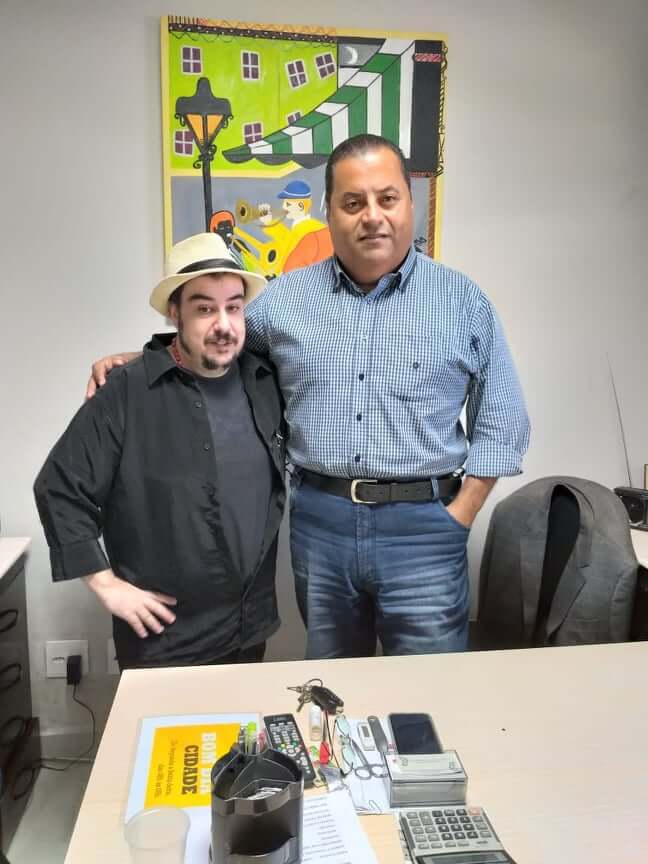
Erminio Matos, knew how to interpret the changes in the listeners’ taste vis-à-vis the rate at which the society changes.
The Radio Guaruja AM 1,550 Khz, has a lot in future with the Directors, who understand that sky is the limit !.
In the Shortwaves of Guaruja Paulista
In 2003, Radio Guarujá AM acquired the tropical band allocations of Rádio Clube de Marília and Rádio Diffuser of Presidente Prudente. The station signed an agreement with DX Clube do Brasil, which produced the Guarujá Paulista shortwave programs between 2004 and 2007.
The presentation was made by DXCB colleagues Sarmento Campos, Célio Romais, Renato Uliana and Adalberto Azevedo (already deceased), with the participation of the DX Clube do Brasil team. In 2007, Radio Guarujá Paulista joined, for a short period, the Radio Globo System and the program ceased to exist.
Studio and Technical Control
The radio station has studio and technical control together in the classic American way, although the announcer is assisted by a technical operator. Without naming brands, we can visualise the following setup:
Studio
The studio is vast so that you can work comfortably. It has a specially designed table, equipped with five condenser microphones and very good ergonomically designed chairs, to work comfortably in a relaxed manner, maintaining good body posture.
The walls and door of the studio are totally isolated from outside noise, with acoustic panels.
Control room
The control room is professional-grade, with all the necessary components to carry out programs. They have: computers with radio automation software, sound console, several audio processors, monitors, televisions with different information channels.
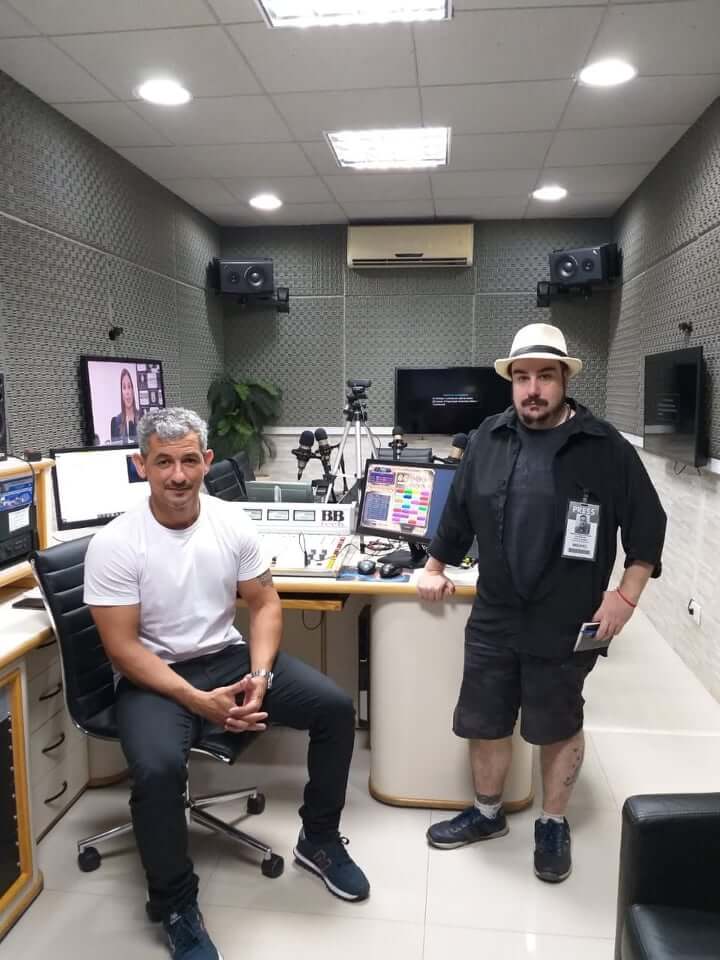
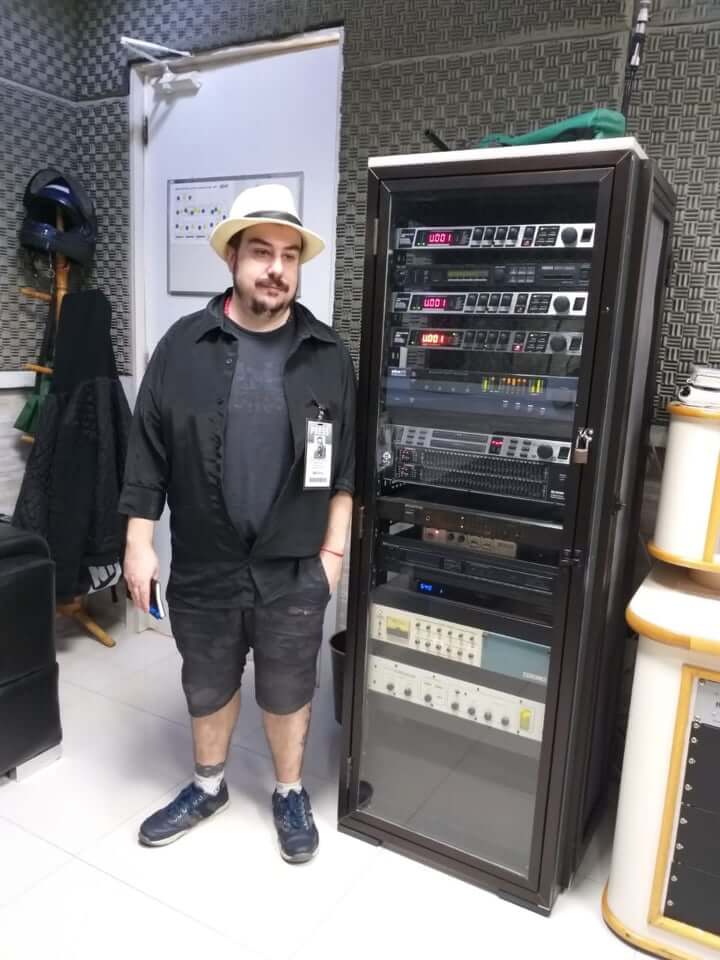
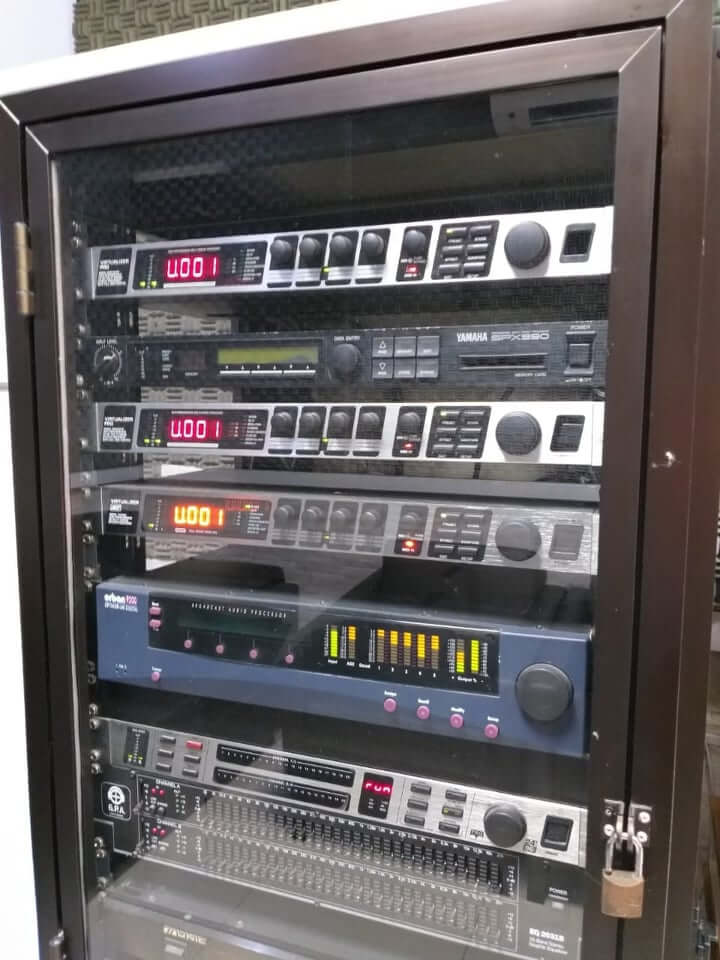
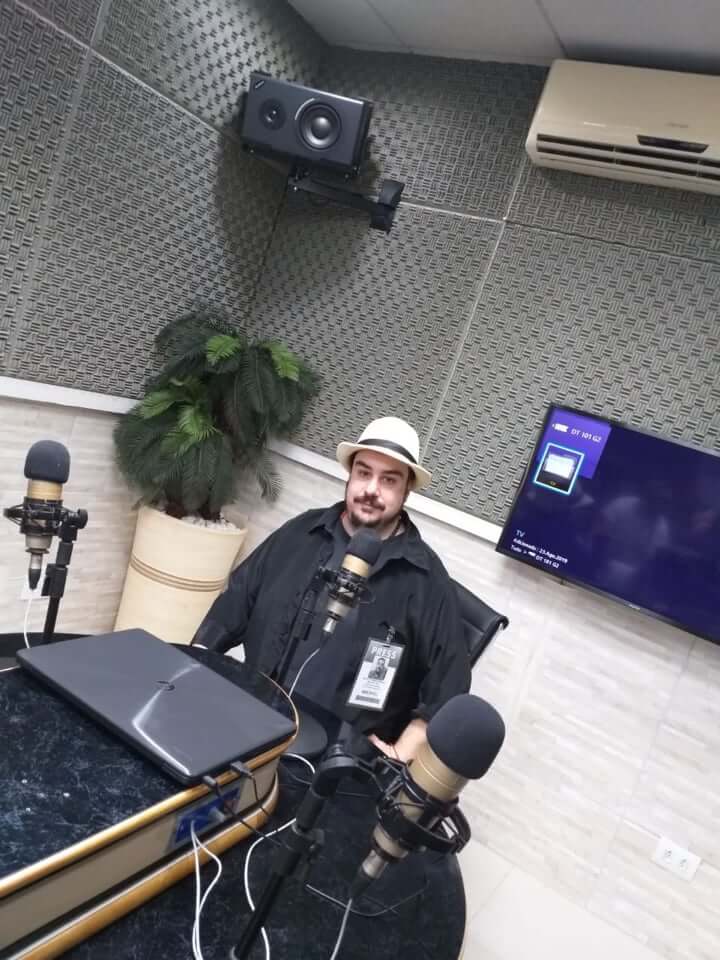
Recording Studio
Radio Guaruja, has a recording studio that’s ideal for recording, editing and mixing different news, advertising and interviews without the need to occupy the main studio.
Here are details of the equipment that make up the recording studio, without naming brands: a good computer, an excellent DAW (digital audio workstation), program used to record and edit, a very good audio interface, mixing console, two high quality studio microphones, headphones, studio monitors.

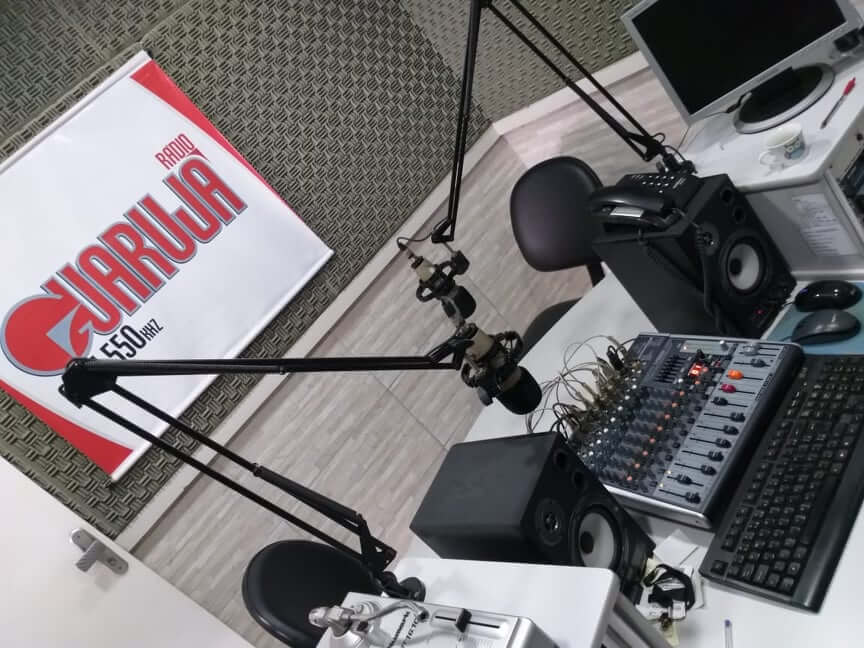
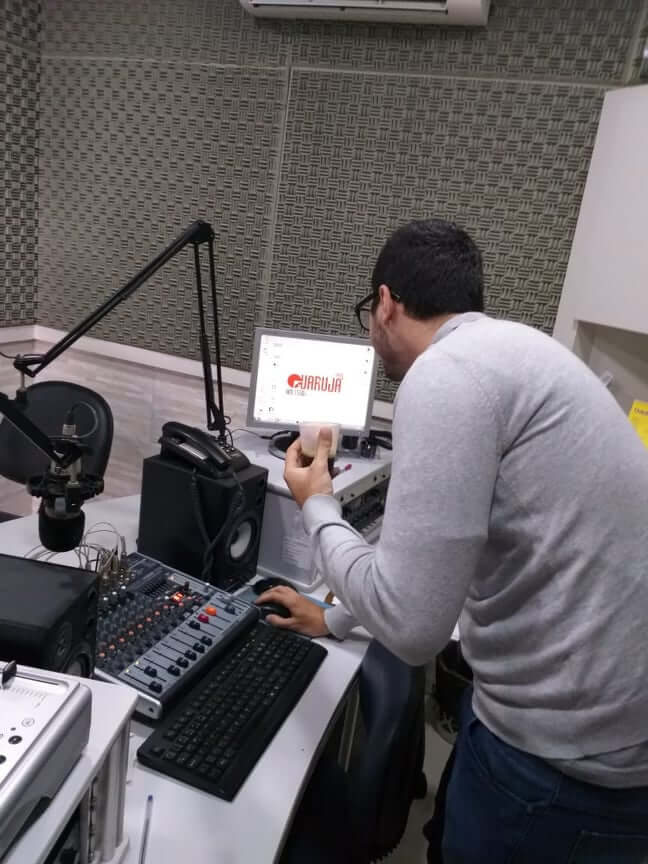
Antenna Field
The AM transmitting plant is on the same site, behind the radio studios.
The antenna is a classic folded monopole over 60 meters high which allows the station to have very good coverage.
On the day of the visit we could not enter the transmitter room.
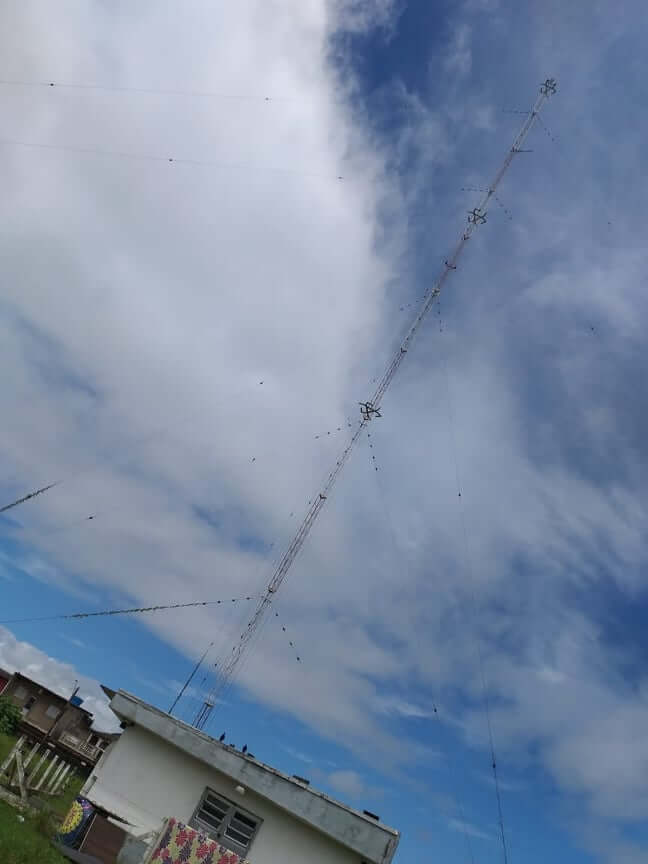


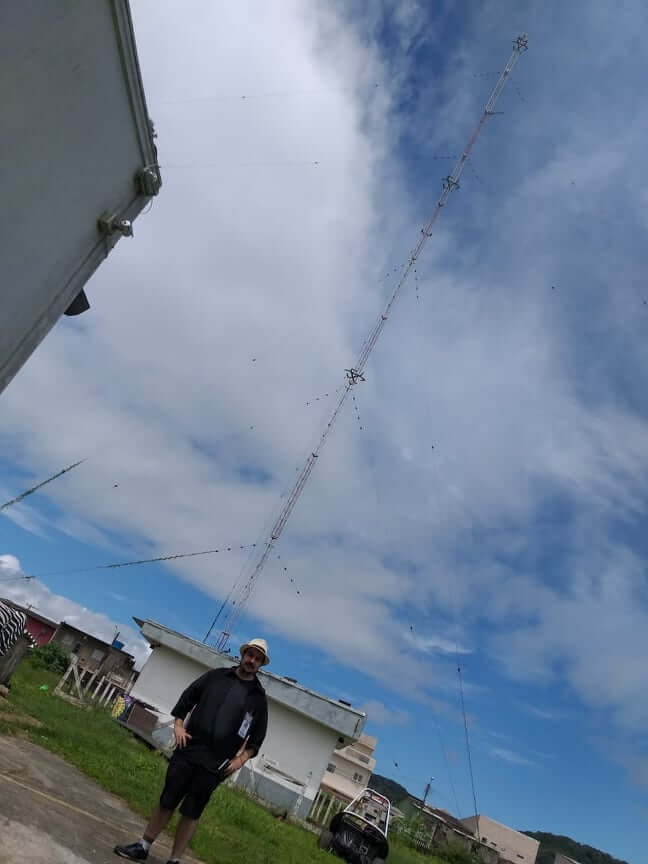
Conclusion
I cannot finish this report without congratulating the Rampazzo family. The Guarujá AM 1,550 kHz radio studios are as modern as the major radio stations in São Paulo and even international stations.
Many say that AM radio is becoming extinct, and that is true, perhaps because AM stations haven’t adapted to modern times.
Erminio Matos, knows how to keep Radio Guarujá evolving, bringing news to the air, and insuring this family’s radio legacy will have an excellent future!
Thanks
To the whole Rampazo Family.
Tourism, Municipal Prefeitura de Guarujá – Sao Paulo – Brazil.
To my wife, Ligia Katze (for the photographs).
To my dear friend Mark Melzi, in photo editing.
To the Colleagues of the DX Club of Brazil (DXCB), Sarmento Campos and Célio Romais https://www.ondascurtas.com/
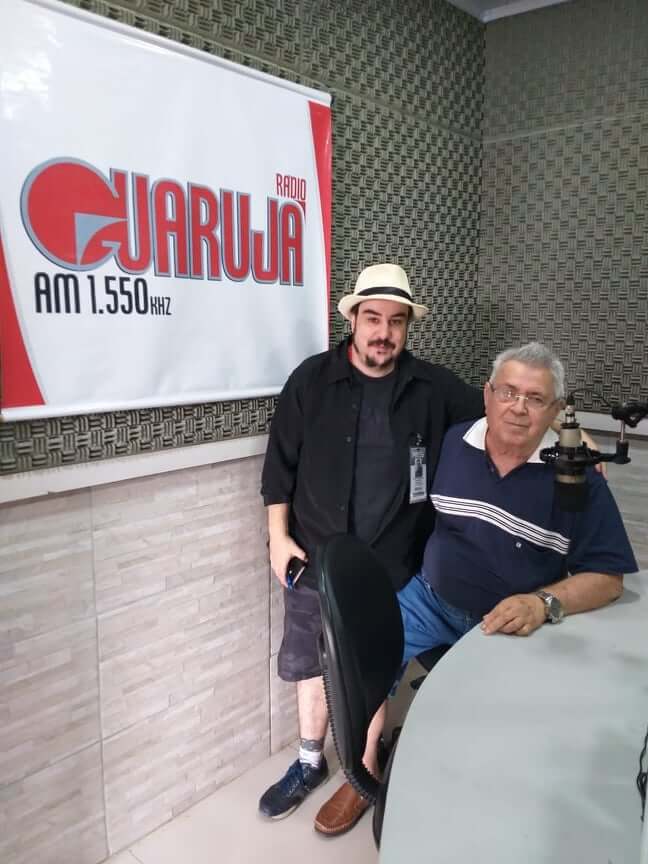
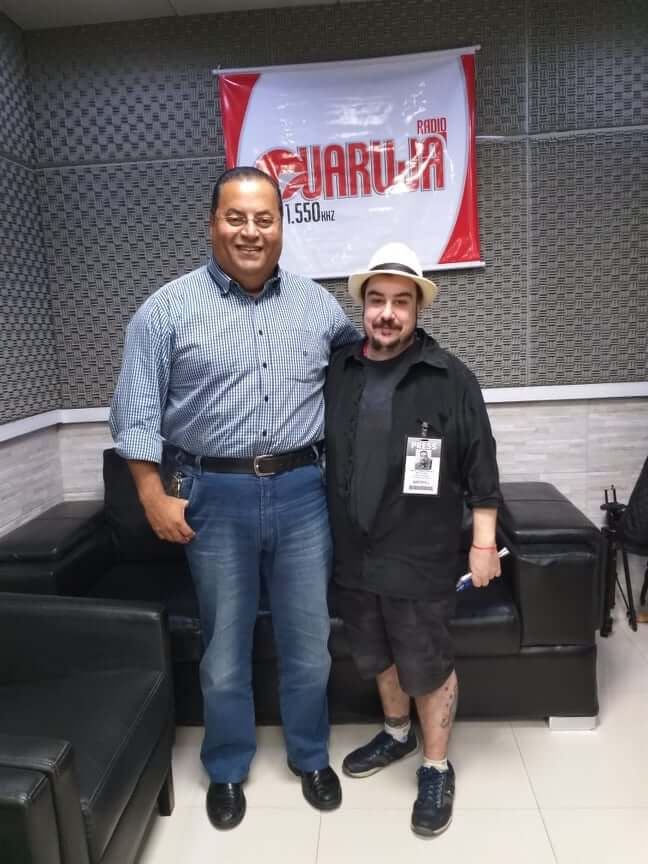
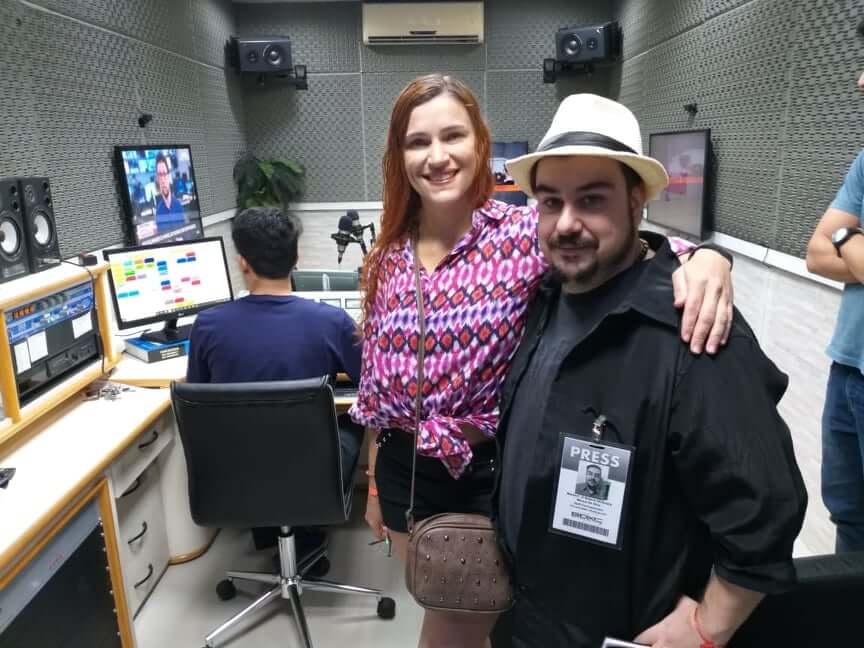
Author’s review
He is a listener of Shortwave Radio and Amateur Radio since 1992 with the Argentine callsign LU9EFO and the Brazilian PT2ZDX.
Martin is a Radio Amateur with more than 30 years of experience, and has participated in DXpeditions throughout South America, with the Argentine radio callsign LU9EFO and the Brazilian callsign PT2ZDX.
Martin collaborates and writes for several Radio newsletters that cover the theme of world radio.
Martin is the founder of CREW called 15 point 61 (15.61, now called just 61 sixty one.
Martín Butera is a journalist, documentary filmmaker and founding member of Radio Atomika 106.1 MHz (Buenos Aires, Argentina) www.radioatomika.com.ar.
He currently lives in Brasilia, capital of Brazil.
References
This visit was made in the middle of the month of October of the year 2019, the report was finished writing at the beginning of the month of November of the same year.
Report and research by: Martín Butera
Photographs and Video (under study) by: Ligia Katze
Photography Editor: Mark Melzi

Excelente matéria. Costumava escutar a Rádio Guarujá de Santos em ondas curtas nos fins de semana, quando ligava o rádio em Curitiba para acompanhar a rodada do campeonato brasileiro. Era muito divertido, pois eu tinha em duas faixas várias emissoras brasileiras de diferentes cidades e estados, cada uma com o seu estilo regional de transmitir as partidas de futebol. Eu também gostava de escutar a cidade do time adversário para saber o que falavam do meu. Minha família tinha uma vida social praticamente nula, e os fins de semana eram muito solitários. O Sanyo duas faixas estava sempre lá para preencher aquelas tardes vazias.